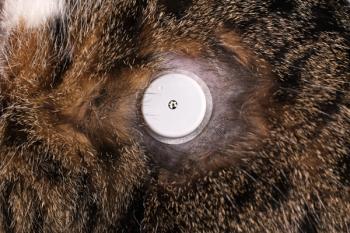
What to do when your insulin therapy stops working: Insulin-resistant diabetes
Insulin resistance is a condition in which a normal amount of insulin produces a suboptimal biologic response.
Insulin resistance is a condition in which a normal amount of insulin produces a suboptimal biologic response. Insulin resistance may result from problems occurring before the interaction of insulin with its receptor (e.g., insulin-binding antibodies), at the receptor (e.g., altered insulin receptor binding affinity or concentration), or at steps distal to the interaction of insulin and its receptor. Post-receptor problems are difficult to differentiate clinically from receptor problems, and both often coexist. In dogs and cats, receptor and post-receptor abnormalities are usually attributable to obesity, inflammation (such as occurs with pancreatitis or gingivitis), a disorder causing excessive secretion of a potentially insulin-antagonistic hormone (such as cortisol in dogs and cats or growth hormone and T4 in cats), or a disorder that causes a deficiency of hormone necessary for insulin action (such as thyroid hormone).
No insulin dose clearly defines insulin resistance. For most diabetic dogs and cats, control of glycemia can usually be attained using 1.0 U or less of NPH, lente insulin or glargine (cats) per kilogram of body weight given twice daily. Insulin resistance should be suspected if control of glycemia is poor despite an insulin dosage in excess of 1.5 U/kg, when excessive amounts of insulin (i.e., insulin dosage >1.5 U/kg) are necessary to maintain the blood glucose concentration below 300 mg/dL, or when control of glycemia is erratic and insulin requirements are constantly changing in an attempt to maintain control of glycemia. Failure of the blood glucose concentration to decrease below 300 mg/dL during a serial blood glucose curve is suggestive of but not definitive for the presence of insulin resistance. An insulin resistance-type blood glucose curve can also result from stress-induced hyperglycemia (cats), the Somogyi response, and other problems with insulin therapy, and a decrease in the blood glucose concentration below 300 mg/dL can occur with disorders causing relatively mild insulin resistance. Serum fructosamine concentrations are typically greater than 500 µmol/L in animals with insulin resistance and can exceed 700 µmol/L if resistance is severe.
Two diseases that have the potential to cause the most severe insulin resistance are hyperadrenocorticism and hypersomatotropism (acromegaly), although insulin resistance may also be mild or variable. Approximately 80% of cats with hyperadrenocorticism and nearly all cats with hypersomatotropism will develop diabetes mellitus. Hyperadrenocorticism is rare: 75% to 80% of cats have pituitary-dependent disease and 20% to 25% have cortisol secreting adrenocortical tumors. In rare circumstances, adrenocortical tumors secrete other steroid hormones (e.g.,progesterone). However, clinical signs are identical to those of hypercortisolism, and diabetes mellitus may develop as well.In addition to PU/PD and weight loss, which are usually due to concurrent diabetes mellitus, typical clinical signs are abdominal enlargement, an unkempt seborrheic hair coat, thinning of the hair coat, failure of hair to regrow, or alopecia and muscle weakness. Severe cases may have thin, fragile skin that tears easily. Cats with large pituitary masses may have CNS disturbances. However, clinical signs may also be mild and hyperadrenocorticism is often not suspected until it becomes evident that the diabetes is difficult to regulate. The dexamethasone suppression test is the preferred screening test. Whether poorly regulated diabetics do indeed have hyperactivity of the hypothalamus-pituitary-adrenal gland axis that leads to abnormal test results is controversial. Based on recent studies, the dexamethasone test (0.1 mg/kg dexamethasone IV with a pre, 4 and 8 hour post) appears to be a suitable part of the diagnostic workup in diabetic cats suspected of having hyperadrenocorticism and should be carried out only after insulin therapy has been instituted for 6-8 weeks to mitigate the effects of poor glycemic control on the HPA axis.
Hypersomatotropism in cats is caused by a growth hormone (GH)-producing tumor (usually an adenoma) in the pars distalis of the pituitary gland. GH has catabolic and anabolic effects; the latter are in part mediated by insulin-likemgrowth factor-1 (IGF-1). The catabolic effects are mainly due to insulin antagonism and are the reason for the diabetes mellitus. The anabolic effects include proliferation of bone, cartilage, soft tissue, and organs resulting in a large body size, broad head and large paws, weight gain, prognathia inferior, respiratory difficulties because of thickening of pharyngeal tissues, degenerative arthropathy, and organomegaly with potential organ dysfunction. Growth of the tumor may lead to signs of CNS disease. As previously mentioned for hyperadrenocorticism, clinical signs may also be very subtle or even absent. Acromegaly has long been considered a rare disorder. However, it was recently suggested that acromegaly occurs more frequently than previously thought and is most likely underdiagnosed. Because the availability of a validated GH assay for cats is inconsistent, diagnosis is usually based on the finding of high IGF-1 concentration. Two important points should be kept in mind. First, circulating IGF-1 is bound to proteins, which must be removed before measurement. Not all assay methods are equally effective, and intra assay inference of binding proteins may lead to false high IGF-1 levels. Therefore, only assays validated for the cat should be used. Second, IGF-1 concentrations are often low in newly diagnosed diabetic cats and increase markedly after initiating insulin therapy. Low IGF-1 levels have also been seen initially in untreated diabetic cats with acromegaly. This observation is explained by the fact that relatively high insulin concentrations are required in the portal vein for the expression and function of GH receptors on hepatocytes, and this mechanism is impaired in insulin-deficient states. IGF-1 is therefore measured 6 to 8 weeks after initiating insulin therapy.
Problems with insulin therapy
- Inactive insulin
- Improper insulin syringe
- Diluted insulin
- Improper administration technique
- Inadequate dose
- Somogyi response
- Inadequate frequency of insulin administration
- Impaired insulin absorption
- Anti-insulin antibody formation (rare)
Caused by concurrent disorder
- Diabetogenic drugs
- Hyperadrenocorticism
- Diestrus (intact female dogs)
- Infection, especially of skin, oral cavity and urinary tract
- Chronic inflammation, especially pancreatitis and oral cavity
- Severe obesity
- Hyperlipidemia
- Hypothyroidism
- Hyperthyroidism (cat)
- Acromegaly (cat)
- Renal insufficiency
- Liver insufficiency
- Cardiac insufficiency
- Pancreatic exocrine insufficiency
- Neoplasia
- Glucagonoma
- Pheochromocytoma
Many disorders can interfere with the effectiveness of insulin therapy. The most common disorders causing insulin resistance in dogs include severe obesity, use of diabetogenic drugs (glucocorticoids), hyperadrenocorticism, diestrus, chronic pancreatitis, renal insufficiency, oral and urinary tract infections, hyperlipidemia, and antiinsulin antibodies in dogs receiving beef source insulin. Obtaining a complete history and a thorough physical examination are the most important steps in identifying these concurrent disorders. Abnormalities identified on the physical examination may suggest a concurrent insulin-antagonistic disorder or infectious process, which will give the clinician direction in the diagnostic evaluation of the dog. If the history and physical examination are unremarkable, a CBC, serum biochemical analysis, serum progesterone concentration (intact female dog), abdominal ultrasound, and urinalysis with bacterial culture should be obtained to further screen for concurrent illness. Additional tests will be dependent on results of the initial screening tests.
Diagnostic tests to consider for the evaluation of insulin resistance in diabetic dogs and cats
- Complete blood count, serum chemistry profile, UA and UMIC
- cPLI (pancreatitis)
- TLI (if suspect EPI)
- Adrenal Function Testing
- Dexamathsone suppression test (cats)
- ACTH stimulation (likely less affected by concurrent diabetes in dogs)
- Thyroid Function Testing
- TT4
- fT4 (if TT4 is less than 1.5 ug/dl in a dog or between 2.5 – 4.0 ug/dl in a cat)
- Serum progesterone levels (diestrus in dogs)
- Serum IGF-1 concentrations (cats with suspected acromegaly)
- Fasting triglycerides and cholesterol
- Abdominal ultrasonography (pancreatitis, neoplasia, adrenal masses or enlargement)
- Thoracic radiographs (cardiopulmonary disease, neoplasia)
- MRI (if document PDH or acromegaly)
Newsletter
From exam room tips to practice management insights, get trusted veterinary news delivered straight to your inbox—subscribe to dvm360.





